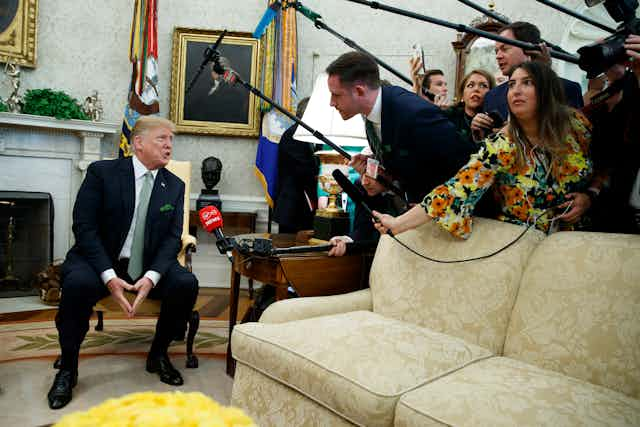You hear a lot of heated claims and baseless generalities these days about what’s wrong with the news media.
What’s seldom heard is what the underlying data indicate about true problem areas and where journalists need to improve.
News reporting requires doing a lot things well, but two crucial elements are being independent of political (or other) interests and knowing one’s subject well enough to select what’s important for the public.
I am a media scholar and former journalist. In my research for my book “The Social Fact: News and Knowledge in a Networked World,” I tried to quantify certain aspects of these two dimensions of news media.
While the overall evidence shows journalists to be ethical in their practice and fair and public-spirited in their mission, I found some troubling signs in my research.
Partisanship
The first question I looked at was whether journalists were partisan. That would affect their stories by making them biased and therefore less trustworthy.
Research in general continues to show news media have left- and right-leaning partisan slants, although the degree depends on the outlet and subject in question.
But one novel aspect to consider in our hyper-polarized, social media-driven age is the relationship between journalists’ work and their online social networks, in particular Twitter, where reporters and editors spend a lot of time these days.
Is partisanship visible not just in the reporting of stories, but elsewhere, in the social networks that journalists inhabit?
As part of a 2018 study with my colleagues Kenny Joseph of the University at Buffalo, SUNY, and David Lazer at Northeastern University, we analyzed partisanship across more than 300,000 news articles produced by 644 journalists at 25 different U.S. news outlets.
We did this using algorithms that helped us sort and analyze each article and journalist, from more conservative outlets such as The Wall Street Journal and National Review to more liberal ones such as The New Yorker and The New York Times.
We looked at the frequency with which key political terms were used, such as “LGBT,” “equal pay,” and “Voting Rights Act” for left-leaning persons, and “bureaucrats,” “illegal immigrants” and “sponsor of terrorism” for right-leaning persons.
We then compared this analysis with a careful look at the individual journalists’ social networks on Twitter – which accounts they follow, and the degree of partisanship of these accounts.
Twitter is a figurative water cooler where journalists spend hours, and surely it shapes some of what they believe is important and colors their views. Research suggests that journalists see Twitter as valuable for their work, and they use the platform at relatively high rates compared to the public at large. We did not design our research to be able to establish true causation, but rather set out to explore just how much of a correlation there was.
Overall, what we found was a modest correlation between the partisanship of the personal network a journalist follows on Twitter and the content she produces. Of course, just because a journalist chooses to follow, say, mostly conservative social media accounts doesn’t mean she will necessarily skew her journalism in that direction. It is not a mechanical relationship. But the data show a reasonably strong connection.
There is solid evidence of partisan segregation stretching across the news and social media worlds, and society should be worried about trends that might make polarization worse over time.
Competence
The second issue to consider in terms of areas of improvement for journalism is the degree to which journalists may not have sufficient knowledge or understanding of certain issues in order to inform the public properly.
Even if President Donald Trump’s criticism of the media is usually bombastic and misguided, it’s certainly legitimate to inquire about the competence and knowledge of news outlets.
We have been asking reporters and editors both about their knowledge and skills and their aspirations for the profession in survey work we are conducting through the Shorenstein Center on Media, Politics, and Public Policy at Harvard.
It’s clear there are many journalists who have substantial knowledge of many public affairs topics. But the profession continues to struggle with competence in a variety of areas, particularly with reporting about numbers, data and research.
Across the board, journalists know they should be better able to do quantitative analysis and interpret information more critically, a finding in our survey research. They know these skills are key to seeing through the potential bias of sources, be they politicians, health care companies, energy firms, Wall Street, Madison Avenue or the White House.
For example, when a police department makes a claim about reducing crime, or a health care provider touts progress on patient safety, skeptical journalists with good data skills will have greater ability to analyze the data themselves, see through faulty claims and call out misinformation.
Yet the training and preparation for the profession of journalism often falls short. As a journalism educator myself, I fully admit that the responsibility and burden are very much on us, as educators, to provide training in these areas, particularly as the world grows more complex and data-driven.
Taking a hard look at the press is not easy at this time, as it can seem to feed the lies about journalism fueled by the president. All of this analysis is not to validate the often poisonous criticisms of the press in recent years, which have tended toward exaggeration.
But if we are to have any hope of regaining broad public trust in professional news media – and improve public knowledge and discourse in the way that most people want – we need to start by getting much more empirical about what is wrong and what is right with our media institutions.


